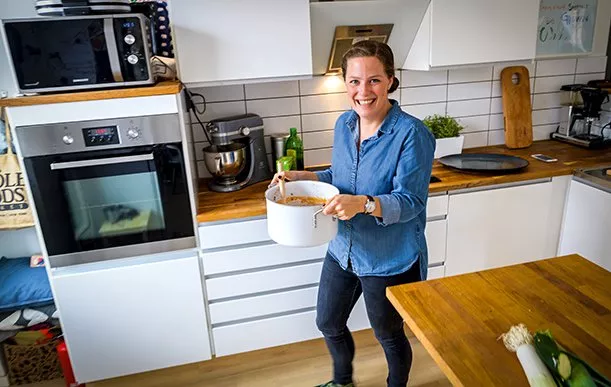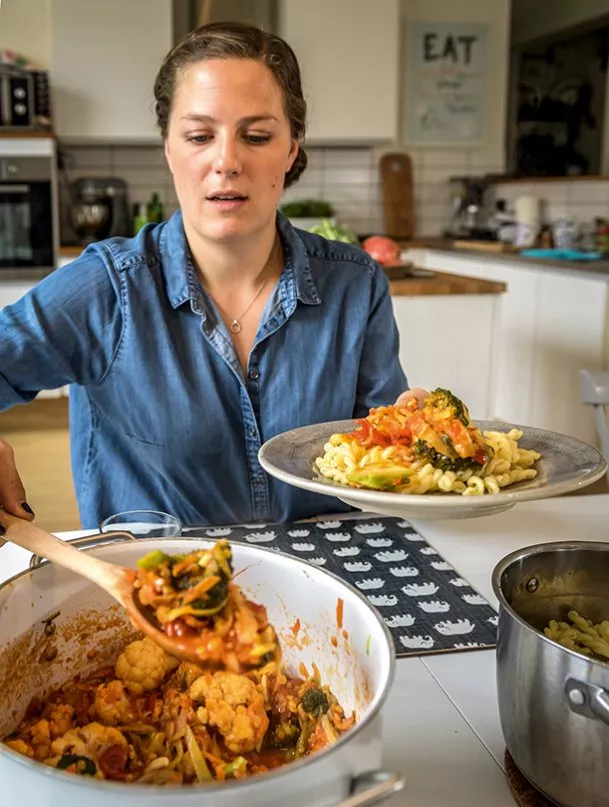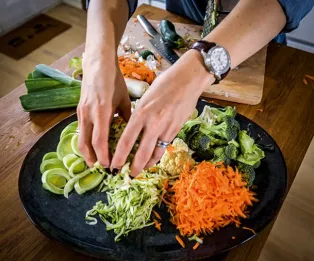Louise Brunkwall knew from an early age that she wanted to work with food. Her interest in food came from both her mother and maternal grandmother, who was a cook at a country estate in Skåne. Louise Brunkwall chose to train as a nutrition physiologist and her current research focuses on the intestinal flora’s role in our health.
The intestinal flora is a hot field of research. The technique of using faecal samples to extract DNA from intestinal bacteria has made it possible to study the entire genetic material and identify all bacteria, viruses and fungi. The intestinal flora differs widely from person to person, but we don’t know exactly what affects the bacteria. There are many aspects to consider and, as yet, researchers know very little.
The Offspring Study, from which Louise Brunkwall collects results for her research, submits human samples and answers questions about what they eat. The initial results show that there may be a connection between BMI and intestinal bacteria.
“We have seen a link to BMI, as certain types of bacteria are more common among those who are overweight. Healthier food choices lower the risk of prediabetes and may perhaps contribute to the growth of good bacteria with positive health effects. However, the differences are not as dramatic as previous, less reliable, studies have shown.”
Louise Brunkwall often says that intestinal bacteria thrive due to Sweden’s dietary recommendations. Eating more fibre is good for our metabolic health, even though thus far we cannot explain why.
“Being overweight is a potential risk factor. Of course, there are those who despite being overweight have good metabolic values, but often there is a strong link between high BMI and impaired health.”
Despite certain individual differences, being overweight is a question of energy in and energy out. And it is difficult to take in the right amount of energy, as the body cannot count.
“It would be great if the body had a function that could count how many calories you consume per day. But, it doesn’t work that way, so we must relate to our own size and energy consumption. My husband is 207 cm tall and I am 158. Our preconditions and our basal needs are very different. But when we go out to a restaurant, we get exactly the same amount of food.”
In historical terms, we have lived for a very short time in the period of abundance we have today and with all the choices that we have to make. Portions and plates have got bigger and the food that we consume is controlled by industry through smart marketing. Larger packs of food mean that we buy and eat more.
“If the bowl of sweets is bigger, I eat more. If there are more kinds of sweets, I eat more. The brain is still adapted for when there was a shortage of food.”
We must outwit our own reptile brain. From an evolutionary perspective, we have a disproportionate number of hunger signals compared with satiety signals. The feeling of being full depends not only on volume, but also on the type of food that we eat. Fat and proteins are important components, as is fibre, which also induces an increased feeling of being full. The biological process for feeling full takes about 20 minutes after you have started eating.
Today’s recommendations to eat a varied diet with plenty of fruit and vegetables and cut down on meat, come from the Swedish Food Agency and are based on Nordic nutrition recommendations. From a health perspective, carbohydrates and fibre are linked to good health. However, both crispbreads and sweets contain carbohydrates, and fat is found in both olive oil and Danish pastries. The quality of the food must thus be a determining factor.
“Eat carbohydrates in moderation – you just have to read the packet to find what the normal portion is. Eat as many pulses as you can. They are inexpensive, eco-friendly and very good for us. Cut down the protein and increase the fibre content. Using beans in a casserole can be the gateway to heavier things such as – bean burgers!”
She considers that if you want to eat better, you have to make an effort – coffee, whisky and beer did not taste good the first time you tried them.
Our food habits have deteriorated over the last few decades. Even though gender equality is positive, it has meant that we do not eat as well, considers Louise Brunkwall. Nowadays, women often work to the same extent as men and instead of food made from scratch you have to find other fast solutions. She thinks that many families have lost their normal relation to food and that it is often a case or either or, black or white.
“Industry profits from our insecurity, for example when lactose-free yoghurt sells for SEK 30. Many people spend a lot of money on products that they don’t need. Compared to other countries, people in Sweden are very trend-conscious when it comes to food.”
Louise Brunkwall thinks that people should ignore trends and diets and instead make long-term lifestyle choices, which means, for example, that we avoid yo-yo dieting. She is critical of books providing advice and recipes that are said to be scientifically based. It is important to differentiate between an isolated study and solid knowledge.
“One study does not mean that the results are reliable and can be repeated. I think that we need to be clearer about how research actually works. Sometimes the impression given is so wrong and it can seem that it takes only a few hours from when a study is completed, to when someone has published a book about it and been interviewed on TV.”
While we have been talking, Louise Brunkwall has chopped vegetables and made pasta sauce. It looks good and healthy, and tastes fantastic. Clearly, it doesn’t need to be that hard to make good and inexpensive food.
Footnote: The article was first published in Lund University Magazine




